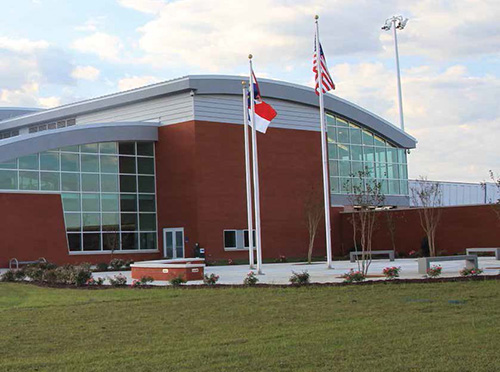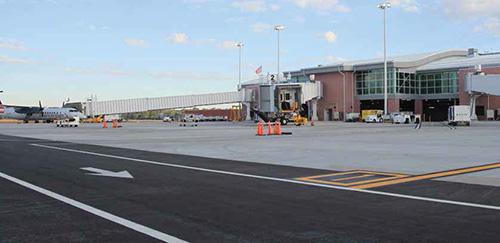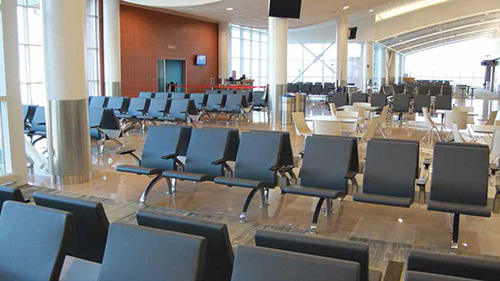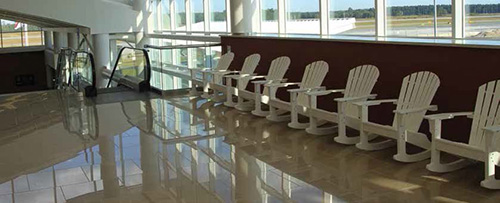Albert Ellis Airport Sequences Funding to Build Small Terminal with Big-Airport Swag

When was the last time you heard about a significant public facility such as a school or stadium being built without dedicated local tax dollars? Albert J. Ellis Airport (OAJ), just outside of Jacksonville, NC, recently pulled it off. The airport's $43.9 million project added new facilities for commercial and general aviation passengers, plus a wide variety of other airside and landside improvements (see list to the left).
"The new terminal was built using transportation grants and airport revenues, requiring no county tax dollars to complete the project," says Airport Director Chris White, A.A.E. "At the end of the day, the funding was a potpourri of sources: FAA discretionary and entitlement funds, passenger facility charges, state grants, contract facility charges (from rental car operations), airport revenues and local government contributions."
OAJ's new terminal opened in August, with four gates and three boarding bridges serving Delta Air Lines, American Airlines and a full-service fixed-base operator. New passenger amenities inside the two-story, 67,000-square-foot facility include updated security checkpoints, dressing rooms for service personnel to change into military uniforms, and seating with digital recharging stations. Expanded concessions are also in the works. Airfield improvements include a runway extension and new taxiways and aprons.
| factsfigures Project: Airport Redevelopment Location: Albert J. Ellis Airport, Richlands/Jacksonville, NC Owner/Operator: Onslow County Main Components: Passenger Terminal with improved roadway access; general aviation facility; taxiways; aprons; runway extension; hangars; rental car quick-turn area Cost: $43.9 million Terminal Opened: August 2015 Funding: $20 million from FAA; $2.5 million from state; PFC; airport revenues Terminal Construction Manager At Risk: Balfour Beatty Construction Executive Terminal General Contractor: Clancy & Theys Construction Co. Civil Construction General Contractor: Barnhill Contracting Co. Designer: RS&H Subconsultants: S&ME; ECS; JSM Assoc.; Cedric Frank Assoc.; Muhlhausen Design & Assoc. Passenger Boarding Bridges: JBT AeroTech Baggage Handling Systems: Grinnell Logan Teleflex Flight Information Display System: Infax Paging System: IED Elevators & Escalators: ThyssenKrupp Seating & Furnishings: Arconas/Delve Steel: SteelFab Roof: BEMO Systems Heating/Venting/Air Conditioning: Humphrey Mechanical Concrete Apron: Ace Electric; GLF Demolition: D.H. Griffin |
White, who previously worked at Dallas/Fort Worth International and Raleigh-Durham International, considers OAJ's recent project unique because it completely modernized the non-hub airport. Between the new passenger terminals, aircraft hangars and a quick-turn area for rental cars, nearly every facility at the small airport was replaced. Only the fire station and electrical vault remain unchanged.
White is especially excited about the continued boost the new terminals and other airport improvements will offer the regional economy. "In 2013, more than 350,000 passengers passed through the OAJ, creating an economic impact of more than $191 million for the county and contributing to 340 local jobs," he reports. "We will expect to exceed that with these new additions."
Booming tourism and explosive growth in the rural area the airport serves helped fuel the development. (OAJ's new commercial terminal includes the first escalators in the county.) White also cites nearby Camp Lejeune, which houses 50,000 marines, as a primary factor. "That alone drives passenger volume," he notes. "Enplanements grew from 119,000 to 170,000 in three years. We needed a new facility."
From Renovation to Renaissance
Personnel from RS&H, the airport's design consultant, note that the terminal project nearly didn't happen. Six years ago, plans focused on renovating the existing facilities, recalls Steve Harrill, the firm's project manager.
That sentiment shifted when White became airport director. "Armed with our analysis, (he) realized it was just as expensive to renovate as it was to build a new terminal," explains Harrill. Renovations would have also inconvenienced passengers more and left OAJ with the inherent disadvantages of a 50-year-old structure that was constructed and designed in a different era, he adds.
According to calculations by RS&H, it would have cost the airport $26 million over a 10-year period to renovate its existing 32,000-square-foot terminal. Taking a different tack, the firm developed plans to build a new 67,000-square-foot terminal on a greenfield site - also for $26 million.
The revised capital improvement project ultimately included provisions to reconstruct the entire terminal area with a new general aviation facility, roadway and apron system. White not only wanted to improve the airport's functionality, he also wanted a signature terminal that would reflect well on the community, Harrill remarks.
Initial reviews since the terminal opened this summer indicate the mission has succeeded, he reports. Much of the excitement swirls around passenger amenities, such as USO facilities for service members, a business center, new concessions, flight information displays and free Wi-Fi. "It offers so much more than your average small airport," says Harrill.
Funding Precedent
The new terminal and other infrastructure improvements would have likely remained on the drawing board without an aggressive plan to finance them. "Albert J. Ellis had not received more than $3 million in discretionary funding from the FAA for capital improvements during its entire (43-year) history," White relates.
As a virtual stranger to the process, OAJ faced a few extra hurdles. White says that FAA officials were hesitant to award the airport money, because they had no idea whether OAJ would secure the matching funds required to move ahead with its plans. "They are reluctant to invest in a project that doesn't make use of allocated money," he explains.
With an administrative staff of three employees, White enlisted RS&H consultants to help. Together, they partnered with Onslow County, which owns and operates OAJ, to secure an $8.5 million loan. Seeing the county's stake in the project, the state of North Carolina subsequently committed $2.5 million to the initiative - a huge increase compared to the $50,000 per year OAJ had typically received, White notes.

After lining up its state funding, the airport then requested $20 million from the FAA. White highlights the role of Tom Slater at RS&H in securing federal funds for the project. "He has long-term relationships with the staff at the FAA and the State Division of Aviation and knows the right approach," White comments.
"We were trying to get them to 'Yes,' and if we showed them the (local and state) money, it would be a lot easier for them to grant it," Slater recalls. "Also, I think the agencies were more generous since we came to the trough so rarely."
White adds that being a county-operated airport helped secure local funds. "At the time we were planning the new airport facilities, governmental leaders were becoming more receptive to redevelopment projects that included a new government center, human services facility and justice complex," he recalls. "They strategically combined the financing of the airport with other projects in order to obtain more favorable financing for all of them."

Low debt service requirements allow the airport to maintain a low cost-per-enplanement, White adds. The enables OAJ to continue improving its facilities without increasing rates and charges to airlines, he explains.
Spring-boarding off that momentum, plans are being made for a new control tower, runway extensions, parking upgrades and other improvements. With the new terminal operational, crews will tear down the original terminal to make room for more parking and a new access road.
Different Delivery Method
OAJ's recent makeover marked a first for the FAA Atlanta Airport District Office, because it was completed by a construction manager at risk. Previously, all projects in the district had followed the traditional design-bid-build method, which requires airports to award projects to the lowest bidders.
Balfour Beatty Construction was selected as the construction manager at risk for the OAJ project based on the firm's qualifications, White explains. As such, it provided input during the design process, assisted with value-engineering and cost estimating, and subsequently used the open bid process to select the lowest-price qualified subcontractors to help complete the project. With its team in place and input added to the design, Balfour Beatty then provided the airport with a guaranteed maximum price.
Using the "at risk" delivery method decreased the amount of change orders needed by creating a more collaborative process, says White. It also increased the participation of small and minority businesses, and ensured that the primary contractor was "100% committed to completing the project on time and within budget," he adds.
Now that the new terminal is open and well received, White realizes what a challenge the project was. "Doing the passenger terminal and the GA terminal at the same time was ambitious, particularly with a small staff," he reflects. "But with the right team of consultants and contractors, we pulled it off."




2022 Charlotte Douglas International Airport Report of Achievement
 Giving back to the community is central to what Charlotte Douglas International Airport and its operator, the City of Charlotte Aviation Department, is about, and last year was no different.
Giving back to the community is central to what Charlotte Douglas International Airport and its operator, the City of Charlotte Aviation Department, is about, and last year was no different.
Throughout 2022, while recovering from the COVID-19 pandemic, we continued our efforts to have a positive impact on the Charlotte community. Of particular note, we spent the year sharing stories of how Connections Don't Just Happen at the Terminal - from creating homeownership and employment opportunities to supporting economic growth through small-business development and offering outreach programs to help residents understand the Airport better.
This whitepaper highlights the construction projects, initiatives, programs and events that validate Charlotte Douglas as a premier airport.
Download the whitepaper: 2022 Charlotte Douglas International Airport Report of Achievement.








